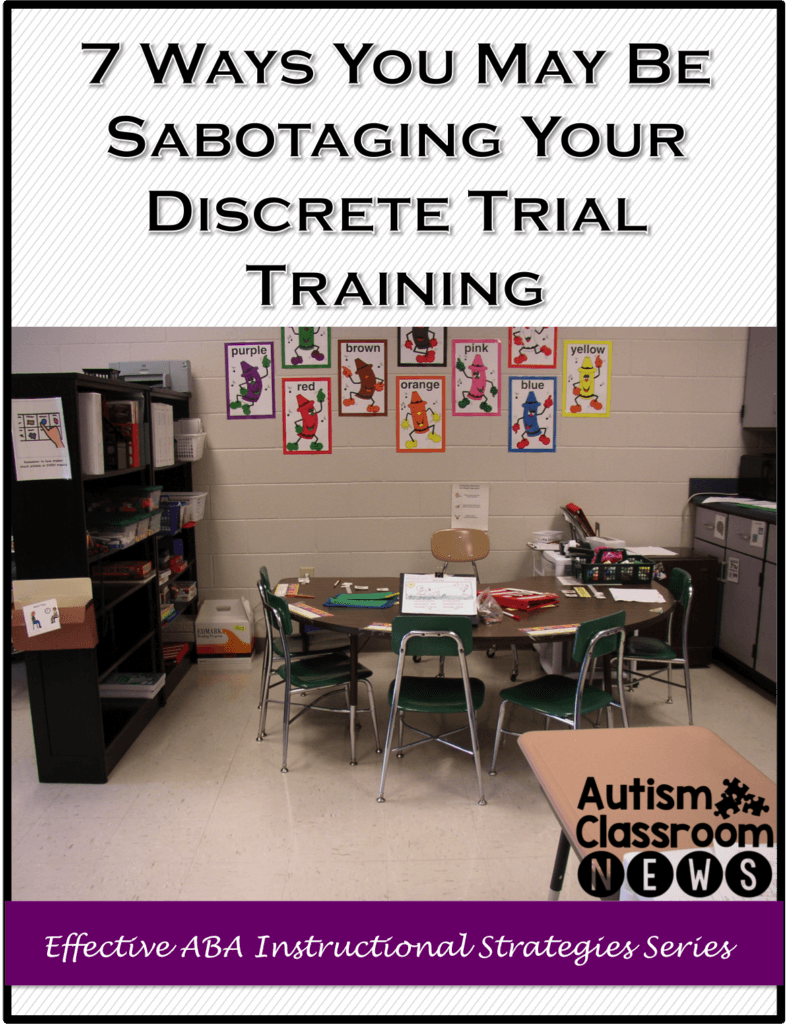Sharing is caring!
Earlier in this series, I talked about things to avoid when giving directions in discrete trial training (DTT). One of those was giving away the answer with your direction. Today I want to focus on 7 things you may be doing in your presentation of instructions and materials that may be giving away undermining your teaching. Essentially they teach the student to attend to the wrong thing.
These are all things that each of us have done at one time or another and they are remarkably easy to do without realizing it. Often you only realize you are doing it when an observer points it out. They are all things I’ve done at one time or another. Once in a while you can say, “oops” and correct it. However, if it becomes a pattern, or happens too often, then you may not be teaching what you think you are teaching.
1. Your smile gives you away
One of the most common and subtle things that give away an answer is when you smile when the learner’s hand goes near the right answer or starts saying the right answer. We smile because we want them to get things right! Our being reinforced by the learner getting it right is a good thing. But if you realize that your student holds out his hand between 2 picture cards and looks at you–chances are you are giving it away.
2. Your frown is giving clues
When the student reaches for the wrong answer, you frown or you wince. Pretty much the same as the one above, but when you are invested in the student being successful, it’s hard to keep your face neutral when you see a problem.
3. Your hand is in the wrong (or right) place
You put out picture cards and you leave your hand by the one you expect the student to hand you. Or, you put out the materials and you leave your hand by the last one you put down (which may or may not be the right answer) and the student always chooses that one. Instead, you want to put out the cards and remove your hands from picture–fold them in front of you or put them under the table.
4. Your voice inflection goes up (or down)
You are giving verbal choices and when you give the right answer, your voice changes pitch. For instance, you present a picture of a cow and ask, “Is this a picture of a cow?” and when you say, “cow” your voice goes up. When you show a picture of a cow and say, “Is this a dog?” your voice pitch goes down.
5. Your placement of materials gives it away
This one is somewhat obvious, but we all do it at some point or another. You put picture or word cards down and you always put the right one in the middle, or on one side. So the student learns to just choose the one on the right, not the correct answer. We need to make sure we mix it up. I will be coming out with a product in the near future that helps to avoid this issue among others.
6. Your order of instructions give it away
You tell a student to stand up and then you tell him to sit down. You never tell him to sit down when he is doing something else. You never tell him to sit down and then stand up. If you tell me to stand up, the next thing I will do is sit down. So the student learns to pay attention to the order of instructions instead of what is being asked.
7. You look at the right answer
Here is the most subtle of them all….you look at the right answer. It’s amazing how the same kid who can’t discriminate the difference between two animals can tell which card your eyes are focused on. Yes, this the same kid who won’t “look you in the eye.” If he looks at your face and gives you the answer, chances are he’s getting some information there that was not part of your learning activity.
So, those are some things to be careful of to assure that you are teaching what you mean to be teaching. This is critical because if the student is attending to the wrong part of instruction, we are not only going to have to reteach that skill, we are going to have to unteach his faulty attention. We will have to teach him to pay attention to the cards, not your facial expression. That’s a long and complex process.
One way to avoid these issues, run your instructional time as if someone from the class or team is absent–I call it the “one man down” plan. This frees someone up to observe sessions and give feedback to about whether these types of errors are occurring. Similarly, you could videotape some of your sessions–but focus the video on you instead of the learner. You can learn a lot from watching yourself…as painful as that can be.
What kind of unconscious cues do you fight against in your DTT sessions? Share in the comments.
I’ll be back time to talk about considerations of presenting materials.
Until next time,








